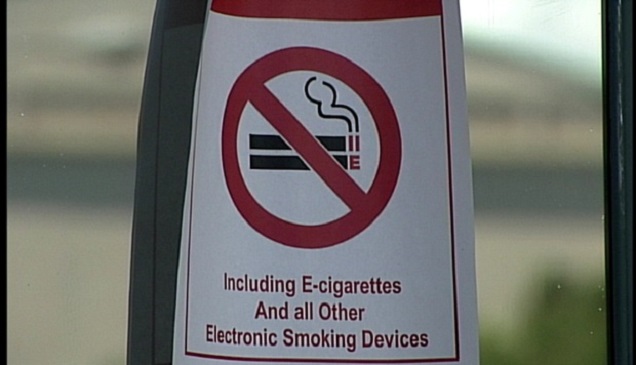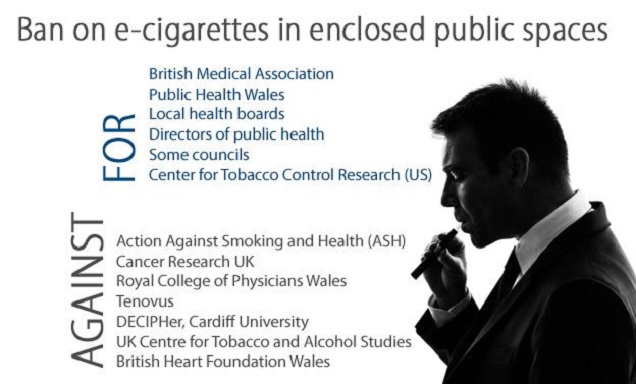
The Welsh government has announced that it will ban vaping in enclosed public places under a new public health law, igniting much debate about the pros and cons of such a decision. As is standard for such anti-vaping legislation, the arguments put forward in favor of it revolve around protecting the public from the potential health risks of second-hand exposure to e-cig vapor and – of course – the fears of vaping “renormalizing” smoking and acting as a gateway to smoking in young people.
The problem is that none of these concerns are backed by the available evidence, and many groups – including ASH, ASH Wales, the British Heart Foundation, the Royal College of Physicians and Cancer Research UK – have come out against the proposals. However, this is an issue that has already been debated around the world, and one that will continue to crop up in the future, so let’s take a critical look at the arguments in favor of such a move.
Wales’ New Rules – No Vaping in Enclosed Public Spaces

The new laws from Wales include a couple of other vaping-related ones in addition to the indoor usage ban. Any retailers selling e-cigs (or traditional cigarettes) will have to join a register, with the aim of stopping sales to minors, and it will also be illegal to “hand over” nicotine or tobacco products to under 18s, including sales over the internet. These proposals are fine with the vast majority of vapers: children can’t legally smoke, so it makes sense that they shouldn’t legally be allowed to vape either (not that this will stop them).
The controversial new rule is the one banning vaping in enclosed public spaces and workplaces, putting e-cigarettes on the same footing as tobacco cigarettes. This will include lorries (i.e. trucks) and taxis, as well as bars, restaurants and all the expected enclosed public spaces. This will probably come into force in 2017, but no firm date is set yet.

Clive Bates quotes several organizations opposing this last move, with this comment from the Royal College of Physicians being most wide-ranging, “There is no evidence that smoking e-cigarettes in enclosed spaces poses a significant risk to other people, and on the basis of available evidence, the RCP anticipates that electronic cigarettes and related products could actually generate significant falls in the prevalence of smoking in the UK, prevent many deaths and episodes of serious illness, and help to reduce the social inequalities in health that tobacco-smoking currently exacerbates.”
On the supporting side, health minister Professor Mark Drakeford said, “This is not an area in which you should wait for proof that harm has conclusively happened. We need to take action now to prevent the possibility of harm.” He also went on to say that there is a “huge amount” of evidence that e-cigarettes are re-normalizing smoking for youth.
The Health Argument – Is Passive Vaping Dangerous?

The health argument is the core bastion of all arguments for bans on indoor smoking. While there are many who question the strength of the evidence (Christopher Snowdon’s book Velvet Glove, Iron Fist offers a detailed look at the research and is well worth a read), we needn’t concern ourselves with that here: let’s just look at what the Surgeon General’s report on the issue says about second hand smoke.
For increases in risk (among adults), these are the only two conditions with sufficient evidence to show a causal link: a 20 to 30 percent increase in the risk of lung cancer from the secondhand smoke exposure associated with living with a smoker, and a 25 to 30 percent increase in coronary heart disease risk.
There is “suggestive” but ultimately insufficient evidence for many other conditions, including breast cancer, nasal sinus cancer, stroke, adult-onset asthma and chronic obstructive pulmonary disease. For youth, there are a couple of respiratory measures with sufficient evidence (for parental smoking), but the picture is much the same. So we’re really looking at increases in risk of heart disease and lung cancer for adults and very little else.
For the smokers themselves, the risk of lung cancer is increased by 23 times for men (i.e. 2,300 percent) and 13 times for women (1,300 percent) – or about 25 times for both, according to the latest Surgeon General’s report. In short, the increase in lung cancer risk from passive smoking is considerably lower than that for an active smoker. Similarly, the risk of coronary heart disease for smokers is increased by about 300 percent, again much more than the increase for those only exposed to smoke passively. This all makes perfect sense: smokers are directly inhaling the smoke, whereas non-smokers are inhaling a tiny fraction of it, after it’s been dispersed into the air.
Now we’re in a position to think about the possible effects of vaping on bystanders. The Surgeon General’s report links the increase in lung cancer risk from passive spoke to the exposure to tobacco-specific nitrosamines, although other carcinogens are obviously relevant too.
However, the evidence on the chemistry of e-cigarettes consistently shows that vapor contains much, much smaller quantities of all carcinogenic components. Tobacco-specific nitrosamines in particular were addressed in a recent study, which found levels of nitrosamines per ml of ordinary tobacco-flavored e-liquid were 564 times lower than in a gram of tobacco, and for naturally-extracted tobacco liquids levels were still 218 times lower. Older studies put the levels at 500 to 1,400 times lower than in tobacco. Other harmful chemicals are also only present in similarly much, much lower levels in e-cig vapor than in tobacco.

So for bystanders exposed to vapor, their inhalation of these chemicals would only be at considerably lower levels than these, particularly if they’re only exposed every so often at work (and not in the manner depicted above). Studies looking at how much exposure there actually is generally show that apart from PG, VG and negligible quantities of nicotine, there are no detectable quantities of nitrosamines released into the air from vaping, and only tiny amounts of any other chemicals, comparable to what you breathe in from “clean” air anyway. And don’t worry, it’s not just one study: pretty much every piece of research on the issue comes to the same conclusion.
Heart disease is more common than lung cancer, so any increase in risk is more significant, but the available (short-term) evidence indicates that even first-hand vaping doesn’t impact on heart functioning, and the same basic arguments are likely to apply. If vaping does carry long-term risk to the heart, the risk to anyone exposed passively will be about 10 times lower, based on the difference in risk for active versus passive smoking, and this is likely only for long-term regular exposure, not occasionally breathing in small amounts while you’re at work.
The message is clear: health concern about passive exposure to e-cig vapor makes fundamentally no sense, because concern about secondhand smoke is pretty much overstated and the risks of passive vapor exposure are likely to be tens to hundreds of times lower than that. The increase in risk for bystanders – if it does exist – will be vanishingly small.
Re-Normalizing Smoking and Gateway Effects
So maybe the health argument doesn’t quite cut it, but what about the “re-normalization” of smoking and the example we’re setting for impressionable youths? Well, these concerns are easier to address, because they’re made based on no evidence whatsoever. Mark Drakeford says there is a “huge amount” of evidence that e-cigs are renormalizing smoking among youth, but I just can’t seem to find any. Evidence on e-cig use by youth is available, but pretty much all of it shows that as vaping becomes more common, smoking declines.
If vaping was “re-normalizing” smoking, it seems that the smoking rate would probably be increasing, and this is not what’s happening. If we go one step further and engage our brains, we can see why that might be: e-cigarette are not cigarettes, so claiming they’d renormalize smoking is equivalent to saying “more people not smoking will lead to smoking becoming more accepted in society.” As Carl V. Phillips puts it, “How could ostentatiously not smoking – sending the signal ‘I used to smoke but I now think it is a bad idea so I vape instead’ – possibly encourage smoking?”
The final nails in the coffin of this argument (which was pretty much hopeless from the start) are that almost all regular vapers are smokers or ex-smokers (the vast majority of whom quit by vaping) in the US and UK alike, and that available evidence on the purported “gateway” shows that it doesn’t really exist.
So how can we reconcile these facts with Mark Drakeford’s unsupported statements? Well, the options are: a) he’s aware of a substantial body of evidence that eludes all searches b) he’s parroting things he’s heard from other people without checking them out, or c) he’s just making stuff up under the assumption that nobody will question it.
Conclusion – There is No Reason to Be Concerned About Vaping in Public Places
There is more that we could add to this topic. One important point raised by Clive Bates and others is that putting vapers – particularly smokers currently trying to quit – outside with smokers will take away one of the benefits of e-cigs to users and increase the temptation to smoke by surrounding them with the thing they really want (akin to making methadone users go to a smack den to take their daily dose). The core point is that there is no reason whatsoever to ban vaping in public places, except for the one they don’t say: they don’t like you doing something that looks slightly like smoking. Would they be able to justify the ban on that basis? Probably not, because it would be much easier to recognize it for what it is: an unjustified attempt to control decisions that should be made by individual establishments and the people within them. Hopefully the rest of Britain won’t follow Wales down this pointless, misguided path.
More info: James Dunworth over at the Ashtray Blog has put together a list of Welsh AMs for and against the ban, along with contact information for them. If you want to help stop this illogical and counter-productive move, get in touch with your AM and let them know how the ban would affect you and other vapers like you! There are more useful tips as to what to say to your AM in the post, if you're unsure.

